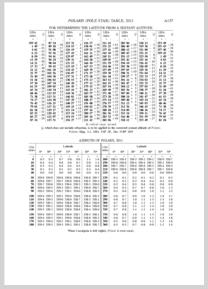
NavList:
A Community Devoted to the Preservation and Practice of Celestial Navigation and Other Methods of Traditional Wayfinding
From: Gary LaPook
Date: 2015 Jun 21, 14:57 -0700
I have posted several times in the past about using Polaris to parctice with an artificial horizon and with bubble sextants and to use Polaris to find the index error of your bubble sextant. Polaris is crossing your meridian about 9:30 pm and am now, the end of June so is a convenient time. Here is a cut and past from some of those posts:
----------------------------------------------------------------------------------------------------------
From: glap...{at}PACBELL.NET
Date: Sat, 17 Feb 2007 03:10:16 -0800
Local: Sat, Feb 17 2007 3:10 am
Subject: Using Polaris
Reply to author | Forward | Print | Individual message | Show original
| Remove | Report this message | Find messages by this author
An easy way to practice with a bubble sextant and to take a number of
observations to allow you to determine its accuracy is to use the
meridian transit of Polaris. When Polaris is crossing the meridian it
is moving horizontally and its altitude doesn't change. For the period
of more than 15 minutes both before and after meridian passage the
altitude of Polaris changes less than one - tenth of a minute (0.1').
For a period of 34 minutes before and after passage the altitude of
Polaris changes less than one half minute (0.5'.) For 48 minutes
before and after its altitude changes less than 1 minute.
Calculate the time that Polaris is crossing your meridian and get out
early and start shooting. It is about 4:45 am and pm now but wait a
couple of months and the time will become more convienent. Calculate
the altitude by adding your latitude to the polar distance of Polaris,
now 43 minutes, and then ADD the refraction correction (yes ADD) which
will then give Hp (precomputed altitude, this is how it is done by
flight navigators) because this porceedure allows you to compare your
Hs directly with Hp to determine the intercept immediately, or the
error in the observation if taken from a known point. If shooting a
lower transit subtract the polar distance from your latitude. You only
have to update this Hp from time as the declination of Polaris changes
slowly.
Gary LaPook
https://navlist.net/m2.aspx/Using-Polaris-check-sextant-sights-LaPook-nov-2008-g6490
From: Gary LaPook <glapook---.net> |
Attached File: 
(img/116416.q-table.pdf: Open and save or View online)
https://navlist.net/m2.aspx/Fw-Shooting-Polaris-with-bubble-sextant-LaPook-may-2011-g16416






